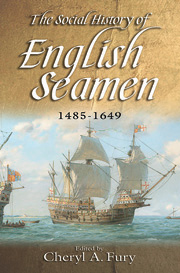Book contents
- Frontmatter
- Contents
- Illustrations
- Contributors
- List of Abbreviations
- Introduction
- 1 The English Maritime Community, 1500–1650
- 2 The Work of G.V. Scammell
- 3 The Men of the Mary Rose
- 4 Tudor Merchant Seafarers in the Early Guinea Trade
- 5 The Elizabethan Maritime Community
- 6 The Religious Shipboard Culture of Sixteenth and Seventeenth-Century English Sailors
- 7 Health and Health Care at Sea
- 8 The Relief of English Disabled Ex-Sailors, c. 1590–1680
- 9 Seamen's Wives and Widows
- 10 Jacobean Piracy: English Maritime Depredation in Transition, 1603–1625
- Conclusion
- Bibliography
- Index
Conclusion
Published online by Cambridge University Press: 05 September 2013
- Frontmatter
- Contents
- Illustrations
- Contributors
- List of Abbreviations
- Introduction
- 1 The English Maritime Community, 1500–1650
- 2 The Work of G.V. Scammell
- 3 The Men of the Mary Rose
- 4 Tudor Merchant Seafarers in the Early Guinea Trade
- 5 The Elizabethan Maritime Community
- 6 The Religious Shipboard Culture of Sixteenth and Seventeenth-Century English Sailors
- 7 Health and Health Care at Sea
- 8 The Relief of English Disabled Ex-Sailors, c. 1590–1680
- 9 Seamen's Wives and Widows
- 10 Jacobean Piracy: English Maritime Depredation in Transition, 1603–1625
- Conclusion
- Bibliography
- Index
Summary
What images emerge from the mists of time of Tudor-Stuart seamen? Clearly, they were youthful and robust if the doomed men of the Mary Rose are in any way typical. Anecdotal evidence supports this. Crew composition may have been more diverse than we are inclined to believe, especially in times of war when seamen were in short supply and non-Englishmen filled out the thinning ranks. The evidence of Dr Stirland's study suggests that they would closely resemble the modern population. Much about their lives are etched into their skeletons: they suffered periods of malnutrition and the various stresses and strains of their occupation. However, overall, they were physically able to meet the demands of naval service against the French during the reign of Henry VIII. This study is invaluable; one only wishes that there was a comparable group of skeletons belonging to men who had spent longer periods at sea.
The maritime community
As David Loades reveals, it is problematic to define the boundaries of the maritime community and which trade group should be included. Our chapters here focus on those engaged in long-distance voyages primarily. In my chapter on women in this volume, I endeavour to show that seamen's wives, widows, sisters and daughters had close ties with those in the maritime trades even though few went to sea.
It is difficult to say how contemporary seamen viewed the membership of their occupational community. Certainly Loades is correct in saying that the boundaries were ‘porous’, with a very fluid membership.
- Type
- Chapter
- Information
- The Social History of English Seamen, 1485-1649 , pp. 301 - 304Publisher: Boydell & BrewerPrint publication year: 2012

